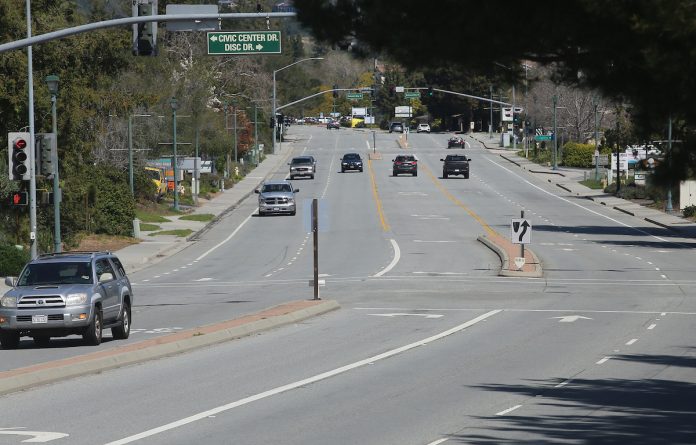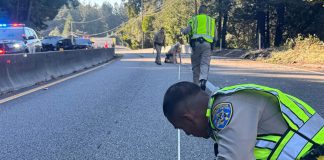SCOTTS VALLEY—The Scotts Valley City Council at its March 17 meeting unanimously approved a detailed plan tabbed by City Manager Tina Friend as a tool that would bring the small city in the northern reaches of Santa Cruz County into the “next generation” of pedestrian and bicycle access and safety.
The City of Scotts Valley Active Transportation Plan (ATP), created by Ecology Action in partnership with Bike Santa Cruz County, is an 81-page document that lays out the current state of the city’s transportation infrastructure, and gives leadership a game plan of how to improve its streets and sidewalks to promote more pedestrian and cyclist activity.
Exactly when some of the recommended projects will be realized, however, is anyone’s guess. The plan does not include a revenue source, or dates of when any of the projects might break ground or head into the planning phase.
Friend did not want to speculate about when Scotts Valley residents could see any of the improvements come to fruition.
“I think our community should think of the ATP as being with us for the long haul, and providing a great set of project ideas that we can draw upon for years to come,” she said.
THE PLAN
The ATP’s creation was funded by a grant from the California Department of Transportation, or Caltrans. Along with providing a vision of a pedestrian and cyclist utopia, similar plans are often used as a mechanism to find funds for projects that a city could otherwise not complete on its own.
Ecology Action Planner Amelia Conlen said nearby cities have used their respective plans successfully to secure funding for needed projects. A prime example, she said, was the city of Seaside’s recent renovations to one of its major arterial roads. That project included separated bikeways, intersection improvements and a “road diet,” or a removal of one or more lanes of travel. Funding for that large project came just months after Ecology Action partnered with the city of Seaside and the Transportation Agency for Monterey County to produce a Complete Streets to Schools Plan for Seaside and Marina.
Closer to home, the city of Santa Cruz was awarded $1.4 million in funding for intersection improvements near schools in 2015. The application was based on the City’s 2015 Santa Cruz City Schools Complete Streets Master Plan.
However, there is no guarantee that Scotts Valley will indeed receive funding after implementing the plan. It also has yet to adopt other policies that those aforementioned cities have such as Vision Zero and Complete Streets, two strategies that not only further encourage pedestrian and cyclist safety but also make a jurisdiction’s grant applications more competitive.
The adoption of both of those policies are included in the recommendations of the ATP.
THE PROJECTS
There are 70 projects included in the plan and they are broken up into three priority rankings: high, medium and low. The projects were placed into their respective categories depending on various factors. If the price and complexity of the project was high, it received fewer points. In turn, if the project received more than five comments from the community during the public outreach portion of the plan’s construction in 2019, it received more points.
The majority (39) fall in the medium priority category, and only seven are deemed low priority. High priority projects included cyclist improvements to the Granite Creek Road overpass, and various changes to Scotts Valley Drive and Mount Hermon Road—the city’s major arterial corridors.
However, Friend says that those rankings do not represent the city’s plan of action going forward.
“The city will look at the ATP and its other existing capital plans, such as our Pavement Condition Report, to help generate project ideas for our future capital planning and grant cycles,” she said. “The ATP presents us with a rich set of project concepts from which we can select to match up with future city priorities and funding.”
The city’s true plan of attack will be determined when it designs it Capital Improvement Plan (CIP), a five-year list of projects that it deems “achievable.” That plan requires approval from the City Council, and a draft should be presented to the public in a meeting in April or May.
THE FUNDING
The city receives about $230,000 annually in Measure D funding that can be used to resurface roads and install bike and pedestrian improvements, but those funds are nowhere near enough to undergo some large, multi-million dollar road renovations included in the ATP.
Friend said Scotts Valley is expected to receive about $2.2 million from the American Rescue Plan, the $1.9 trillion stimulus bill recently signed into law by President Joe Biden. It is not yet known if there will be any restrictions on what that money could be used for, Friend said, but, like other cities across the country, the Covid-19 pandemic has not been kind to the small city of about 12,000 people.
“We have a tremendous level of need throughout the organization,” Friend said.
Those budgetary constraints will likely limit the scale of projects the city can realistically achieve. That means large-scale renovations such as a possible removal of lanes on Scotts Valley Road will not be on the docket for many years—its approval alone requires a rigorous and somewhat pricey traffic study.
But there will still be opportunities for the city to make small changes in the near future, Conlen said. As a way to save money, many cities implement alterations to bike and pedestrian lanes while completing road resurfacing projects.
“This is the most cost-effective way to construct projects that involve roadway restriping, such as enhanced crosswalks, buffered bike lanes, or separated bikeways,” she said.
THE COMMUNITY
Ecology Action received about 500 responses to a survey asking Scotts Valley residents about the state of the city’s streets in 2019. It also held a town hall meeting around the same time that drew a few dozen people.
The overwhelming feedback was that Scotts Valley Drive and Mount Hermon Road needed some major work. Residents also said that they wanted bikeways and sidewalks to be separated from the road, that the center of the city should be more walkable and that the Highway 17 overpasses were unsafe.
But none of those concerns arose during the March 17 meeting. Instead, a group of residents from the Bluebonnet Lane neighborhood shared its concerns about speeding cars and a lack of traffic calming measures along the short street that connects Kings Village and Bean Creek roads.
Scotts Valley Chief of Police Steve Walpole, however, said that the majority of the city’s collisions happen on Scotts Valley Drive, Glenwood Drive and Mount Hermon Road, and that there were only five collisions from 2014-2019 on Bluebonnet Lane.
“That’s a very low number,” Walpole said.
THE NEED
Even with changes to infrastructure, getting people out of their cars will undoubtedly be tough. Nearly three-quarters of Scotts Valley residents who are employed drive to work alone. In addition, more than half of those residents travel more than 20 minutes to get to work, and nearly a third commute for 45 minutes or more.
But most Scotts Valley residents do live within two miles of a grocery store, and the majority of elementary and middle school students are also within the same distance from their respective campuses—about 43% of high school students are, too, within two miles of Scotts Valley High. If infrastructure is provided, the plan argues, those short trips to the grocery store, and to and from campus could instead be done on foot or bike.
It is unknown whether residents will make that change even if the infrastructure is provided, but council member Jim Reed argued that the pandemic could have been a tipping point for communities to reimagine how they get around.
“We’ve gone through this earthquake-like shift that Covid has brought in human interaction, and it’s going to be so long before we figure out the long-term implications of that—for good and bad,” Reed said. “But I think we can all agree that one of the obvious good-news areas is this has given people a lot better understanding and appreciation for why and how they can be active in their own community….It bodes very really well for the type of pedestrian-, bike-friendly town we’d like to be.”








